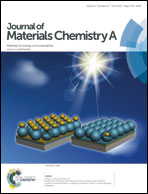Multifunctional and robust covalent organic framework–nanoparticle hybrids†
Abstract
Highly dispersed Pd(0) nanoparticles were successfully immobilized into a stable, crystalline and porous covalent organic framework (COF), TpPa-1, by a solution infiltration method using NABH4 as a reducing agent. High resolution and dark field TEM images confirmed the uniform loading of the Pd(0) nanoparticles into the TpPa-1 matrix without aggregation. This hybrid material exhibited excellent catalytic activity towards the Cu free Sonogashira, Heck and sequential one pot Heck–Sonogashira cross-coupling reactions under basic conditions, and with superior performance compared to commercially available Pd supported on activated charcoal (i.e., 1, 5 and 10 wt%). Additionally, the precursor Pd(II)-doped COF also displayed competitive catalytic activity for the intramolecular oxidative biaryl synthesis under acidic conditions. Both catalysts were found to be highly stable under the reaction conditions showing negligible metal leaching, non-sintering behavior, and good recyclability. To the best of our knowledge, the organic support used in this work, TpPa-1, constitutes the first COF matrix that can hold both Pd(0) nanoparticles and Pd(II) complex without aggregation for catalytic purposes under both highly acidic and basic conditions.


 Please wait while we load your content...
Please wait while we load your content...